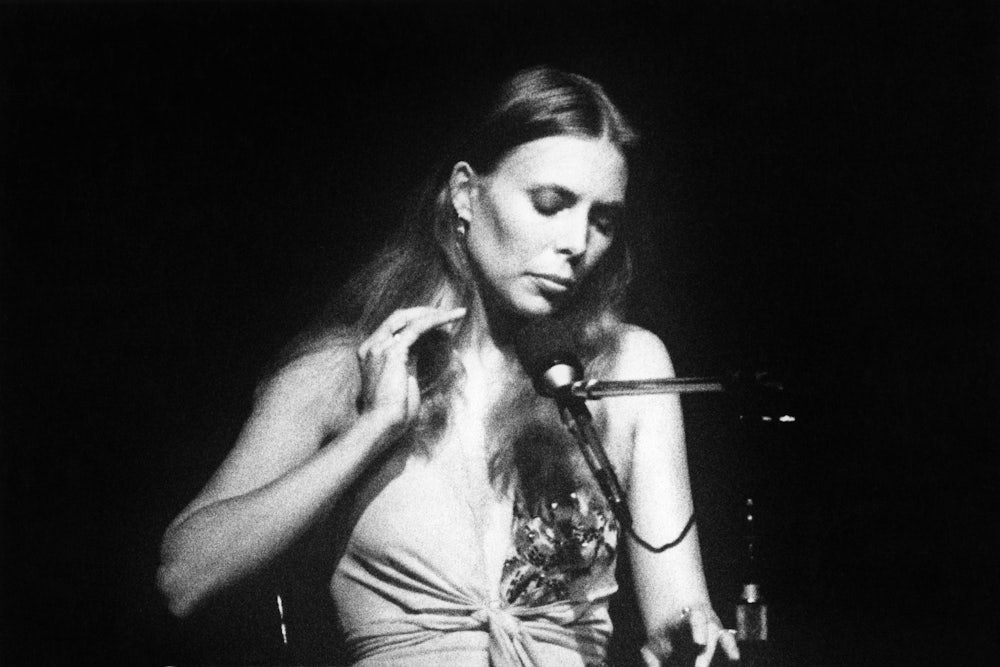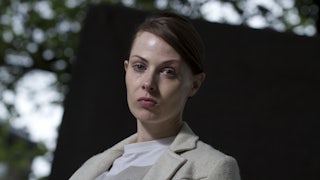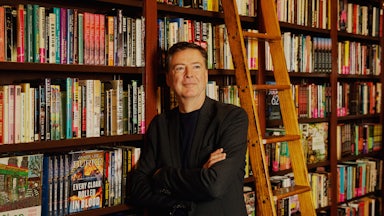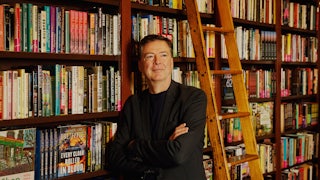The British poet Amy Key was 14 when she first heard Joni Mitchell’s 1971 album Blue. Her best friend had come round for a sleepover, and the two of them listened to the album on cassette by the light of Key’s lava lamp (it was 1992). The songs on Blue are restless and reflective, full of longing and regret, and they “ignited [Key’s] desire and ambition for romantic love.” In particular, she was seduced by Mitchell’s acknowledgment of love’s complications: Love made you suffer, made you make others suffer, but somehow was worth it. Key felt herself to be standing at the border of womanhood, a realm of romantic intensity. She was ready.
And yet, in the three decades since, romantic love has been largely absent from Key’s life. “The last time I had a boyfriend I was twenty-two. I’m about to turn forty-four,” she writes at the beginning of Arrangements in Blue, a memoir developed from an essay that appeared in Granta in 2020. There have been love affairs, crushes, and rejections both given and received, but not the great romances or long-lasting partnership Key once imagined herself having.
How can a woman give shape to her own life, her memoir asks, without the milestones of conventional romantic relationships? What other milestones or narratives are possible, outside of the happy-ever-after offered by fairytales, nineteenth-century novels, and romantic comedies? These questions are also at the center of Joanna Biggs’s A Life of One’s Own, which recounts Biggs’s decision, aged 34, to separate from the husband she had met at 19.
Feeling out the contours of their own unexpected lives, Key and Biggs both summon the lives and works of other creators for help. Key turns to the 10 songs on Mitchell’s album Blue, using each song to think through how singleness has shaped her life socially, emotionally, and materially. Biggs draws on the lives and writings of eight women, starting in the eighteenth century with Mary Wollstonecraft and ending with the still-living Elena Ferrante (a teasing choice, since almost nothing is known about the writer behind Ferrante’s pseudonym). And so both works also ask: How might art lead us astray, or toward new forms of living?
“I want to topple romantic love from its central position,” Key declares in Arrangements in Blue. Her statement recalls a spate of books published in the mid-2010s that claimed or were understood to claim that romantic partnership need not be the most important thing in a woman’s life. Sheila Heti’s How Should a Person Be? and Ferrante’s Neapolitan Quartet suggested that friendship could be just as fraught and absorbing as romance. Kate Bolick’s Spinster combined memoir and biography to celebrate choosing not to marry; Rebecca Traister’s All the Single Ladies depicted single women as a progressive social and political force throughout American history. Arrangements in Blue is in some ways a successor to these works, but it is less boosterish, more ambivalent and knotty, than Bolick’s or Traister’s book. Key may want to topple romantic love from its central position in our collective life, but she also wishes it were at the center of her life, or at least one of the things at its center. Her book asks how to build a good life when you don’t have what you want—and how to do so without denying what it is that you want, or the possibility that what you want may come along.
Admitting that you can’t manage to get what you want is embarrassing. There have been times Key has pretended, to herself and to others, that she no longer wants romantic partnership, and times when she has minimized the pleasures of her single life, lest those pleasures seem pitiful or trivial. These pretenses and minimizations are part of what prompted her to write the book. “I’m motivated,” she tells us, “by how alone I have felt in this situation, how ashamed.” Mitchell’s album offers Key a kind of companionship as she examines her feelings about being single: to write sincerely about one’s desires, in dialogue with songs that are also undeniably sincere, and undeniably about desire, is to be less alone in those desires. Through music, Key often finds a way out of embarrassment and self-consciousness, and toward intimacy: She bonds with friends over particular songs or bands, plays the piano to them, and sings along to Blue alone and with others. (She also once sang the entirety of Jeff Buckley’s Grace—an album 51 minutes long—to a lover, “and didn’t feel embarrassed about having done so until years later.”)
The subtitle for each chapter in Arrangements in Blue is a lyric, chosen because of a question it raises for Key. “The bed’s too big, the frying pan’s too wide” (from “My Old Man,” the second track on Blue), a description of how the singer feels when her lover is out of town, asks Key to consider her experience of living alone—and to realize that she’s quite happy with her empty bed, which “never feels too big for me.” On the other hand, she longs for the intimacy of cooking, routinely, for and with someone else: More than romantic intensity, she feels the lack of romantic companionship. “Clean white linen and my fancy French cologne” (from “Carey,” Blue’s sixth track) makes her wonder about the relationship between self-love and love received from others. “Part of you pours out of me” (“A Case of You,” the ninth) leads her to reflect on the intertwining of her existence with those she loves platonically. And while friendship doesn’t take center stage in Arrangements in Blue, as it does in Ferrante’s and Heti’s novels, Key finds that her friends do provide aspects of the domestic companionship she hopes to share with a partner. She has a couple of friends who, “without my asking … take out the rubbish when they leave”; with another friend, now dead, she did often prepare “the fanfareless meals I imagine exist in cohabitation.” Reading Arrangements in Blue as someone who does cohabit with a romantic partner, and who lives far from most of her friends, I envied the dailiness of friendship in Key’s life, and the open-endedness and generosity of the parties, dinners, and pub hangouts she describes.
Arrangements in Blue examines how a single person—or any person—might replicate aspects of romantic partnership in their nonromantic relationships. But it also points out that the structure of society makes romantic partnership, for most people, the precondition for certain things not inherently related to romance. Homeownership, granted out of the reach of many couples, is even harder to access with only one income. Key describes watching, in her late twenties and early thirties, friend after friend buy a home either with money from parents or through combining resources with a partner. (For a long time, Key assumed she would never own property; the combination of a redundancy package, a government assistance program, and a few small and unexpected sums from relatives finally allowed her to buy a tiny apartment that she describes in gorgeous, loving detail.)
And then there are children. “Little Green,” Mitchell’s song about the baby daughter she placed for adoption, leads Key to recall the abortion she had while a student, and her subsequent longing, in her late thirties, to have a child. In the U.K., the National Health Service funds fertility treatment. But, at the time that Key made inquiries, queer couples or single people could only access that treatment after spending several thousand pounds of their own money. “My life’s desire—my seemingly urgent need to live out the cycle of life as others did—was not approved of, not deemed necessary for a single person,” Key writes. Though other factors ultimately determined her decision not to pursue motherhood, the NHS’s policy illustrates that relationship status is a political category as well as an emotional and interpersonal one.
Examining her feelings about not having a biological child, Key looks for experiences of mothering that take place outside of the parent-child relationship. She thinks of the bonds that she has with children she knows, including her nephews and nieces; the adults on whom she lavishes loving care; even the nurturing that she directs toward herself. But fully equating these with motherhood is unsatisfying: not because they are less significant or valuable experiences, but simply because, although they have things in common, they are not the same. To pretend otherwise obscures their particularity, and the particularity of Key’s own life. (The “more honest parallel to raising kids,” she feels, is looking after her cats—“but who would want to invite the ridicule or pity that can conjure?”)
Central to Key’s understanding of her singleness is the fact that she hasn’t chosen it; central to Joanna Biggs’s is the fact that she has. Key describes watching the domestic routines of couples in their kitchens, feeling as if she’s taking “huge gulps of yearning”; Biggs, a British writer and editor now living in New York, recalls that deciding what to have for dinner every day was “one of the things [she] hated most about being married.” Sharing an apartment with a dear friend some years later, she is surprised to find that “there are a million solutions to what to have for dinner,” and that preparing food with another person can be a joy. Domesticity is a slog when you’re playing a role in a script that feels forced upon you; it can be a pleasure when it’s part of a narrative you’re writing for yourself.
Biggs’s book begins with an ending: the ending of her marriage, which is also the beginning of a life that feels more truly hers. The eight female authors who accompany her through the establishment of this new life are organized more or less chronologically, and Biggs moves more or less chronologically through the seven years that have passed since her divorce. A single chapter is not much in which to cover the life and works of George Eliot or Virginia Woolf or Toni Morrison, and so A Life of One’s Own focuses on ruptures and transitions: those moments when one kind of existence comes to an end and another must take its place. We have Wollstonecraft’s anguished letters to the lover who abandoned her (Biggs recalls sending similarly anguished emails) and subsequent suicide attempt, followed by a period of creative and personal fulfillment. The protagonist of Zora Neale Hurston’s Their Eyes Were Watching God, as well as Hurston’s own life, offers models of post-divorce love and desire; Woolf’s shift in her attitude toward her dead mother suggests to Biggs that she can shift her own relationship with her mother, as the latter moves through the stages of Alzheimer’s disease.
This is literary criticism as a form of self-fashioning, even self-help. Biggs is clear that she wants to unlearn the more academic mode of reading that she felt was expected of her first as an undergraduate and then as an editor at a literary magazine. “I used to want desperately to be a ‘proper’ critic,” she writes, and to “have a full command of history and theory, but I don’t want that anymore.” Instead, she wants to be transformed by reading, to find within books and the lives of those who write them new possibilities for living. Elena Ferrante’s insistence on anonymity, for example, is a reminder that “some privacy is needed when you are making something new.” Learning about the unconventional lives of others might lead you to “speak up at the dinner table” like Mary Wollstonecraft, or “take up drinking wine and crying” like Simone de Beauvoir. “You might try an open marriage or decide to have a child with a lover or determine to lie to get ahead,” Biggs writes. Many nineteenth-century writers and critics also regarded reading as a way to transform one’s character, but for them, the transformation was a moral one. For Biggs, reading is not a tool of self-improvement but a route to freedom: something that can give you permission to identify your desires and act on them.
The subtitle of A Life of One’s Own is “Nine Women Writers Begin Again,” but I couldn’t always tell which moment in each mini-biography was the decisive new beginning: These writers have to begin again, and again, and again. So does Biggs: While her divorce is the most obvious beginning again, her move to New York during the pandemic is another, and her mother’s death another still. This is another thing biography can do: remind us that a life often looks more like a series of experiments, each one proceeding from the results of the last, than a coherent narrative.
Biggs first encountered several of the authors in A Life of One’s Own when she was a teenager or a student; Key has spent 30 years listening to Blue. Living alongside a novel or an album for decades can be a way to measure how much one has changed. Which lyric or scene jumps out at you now that didn’t then? Which misleading or destructive ideas did you absorb from early reading or listening that you now want to unlearn?
In the last chapter of A Life of One’s Own, Biggs compares her two readings of Ferrante’s Neapolitan Quartet, the first in 2015, shortly after she had separated from her husband, the second seven years later. On her first reading, she reviewed the final volume in the quartet for the London Review of Books, and A Life of One’s Own reproduces paragraphs from that review, so that Biggs can assess how her understanding of the novels has changed in the interim. Now she reads Ferrante’s novels less optimistically: still as offering new forms for women’s lives, but also as showing that new forms cannot always bear the weight placed upon them. Some of what Biggs envisaged for her life post-marriage has not come to pass; some of it came to pass and then came to an end. We can make choices, but many of the consequences of those choices, good and bad, are hidden from us in the moment of choosing. Biggs chose single life in a way that Key did not, but both writers ultimately acknowledge their lives to be the product of choice and circumstance combined—and that in this respect, they are no different from their partnered friends.
In this acknowledgment, Arrangements in Blue and A Life of One’s Own are as much confrontations with the beginning of middle age as they are memoirs of living outside of romantic partnership. Youth can give the illusion of endless possibilities, and middle age may mean coming to terms with what has not happened and what may never, accepting the shape of life as it has turned out, without denying the possibilities that remain. Key, like Biggs, writes while grieving the death of someone she loved: her friend and former poetry teacher Roddy. Both Biggs and Key describe mixed feelings about the likelihood that they won’t have children. Outside of the constraints of romantic convention, the second half of a life can be many things—but for better and for worse, it cannot be free of what has come before.






